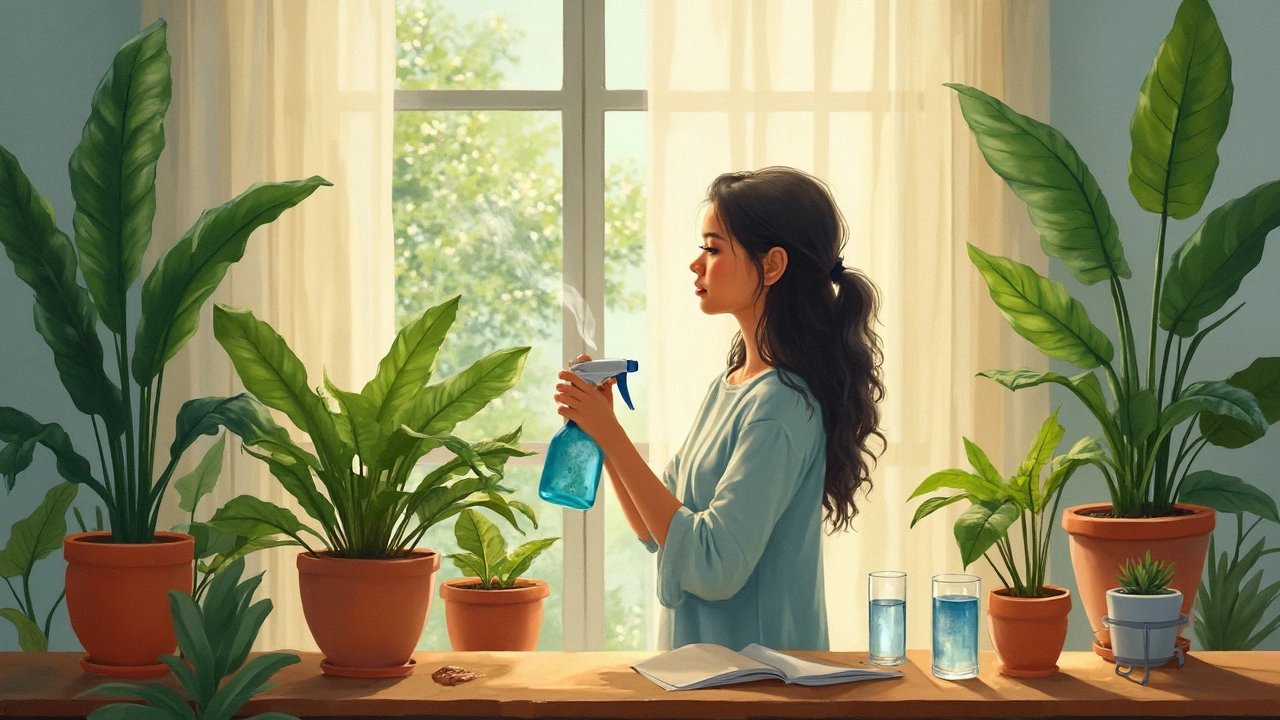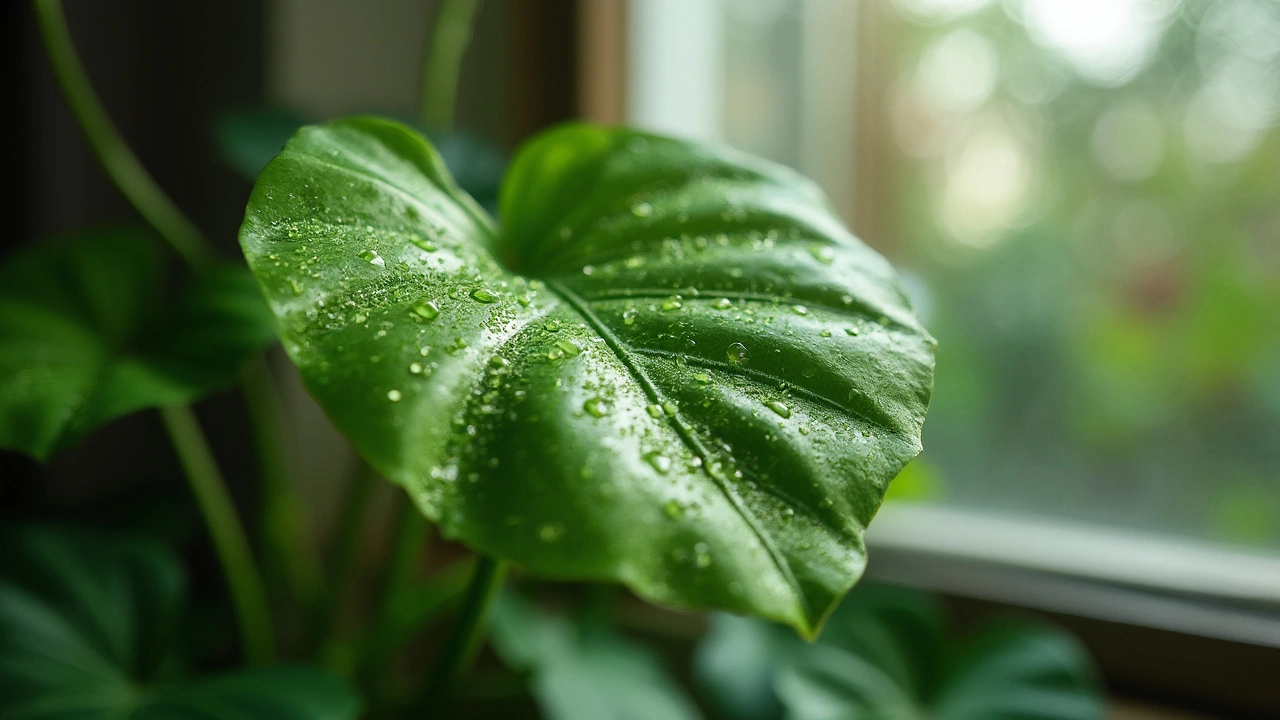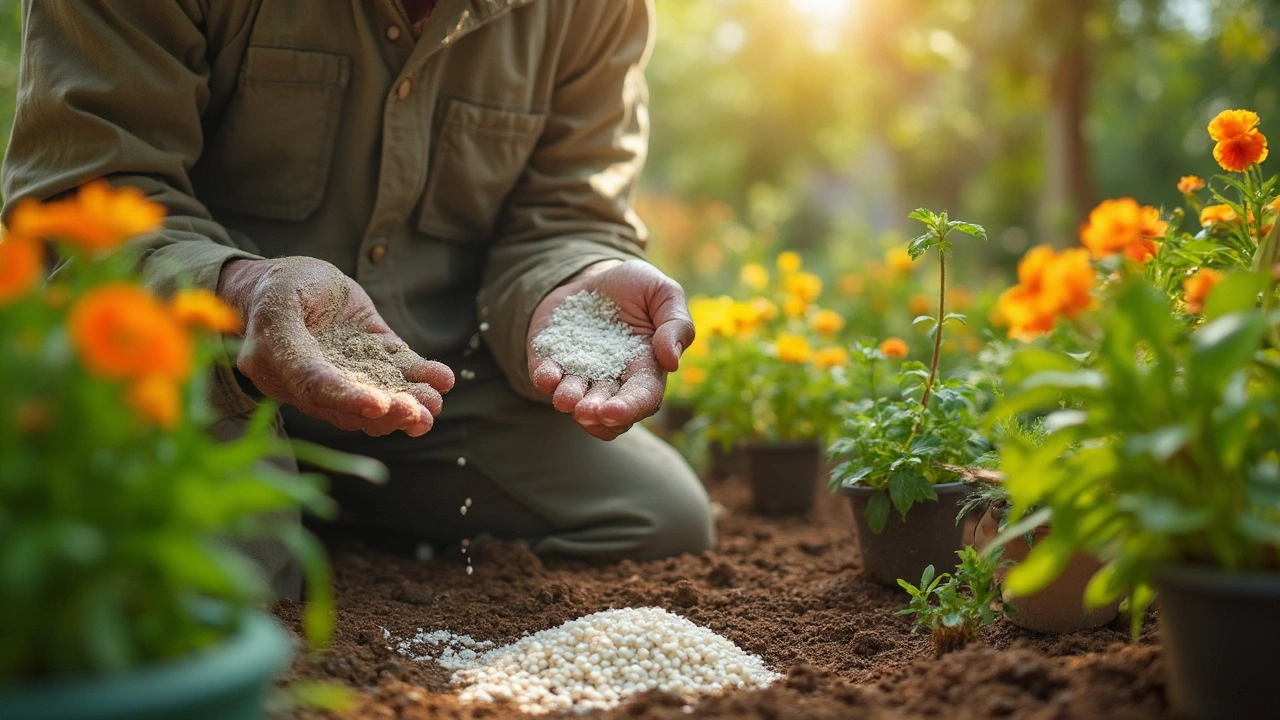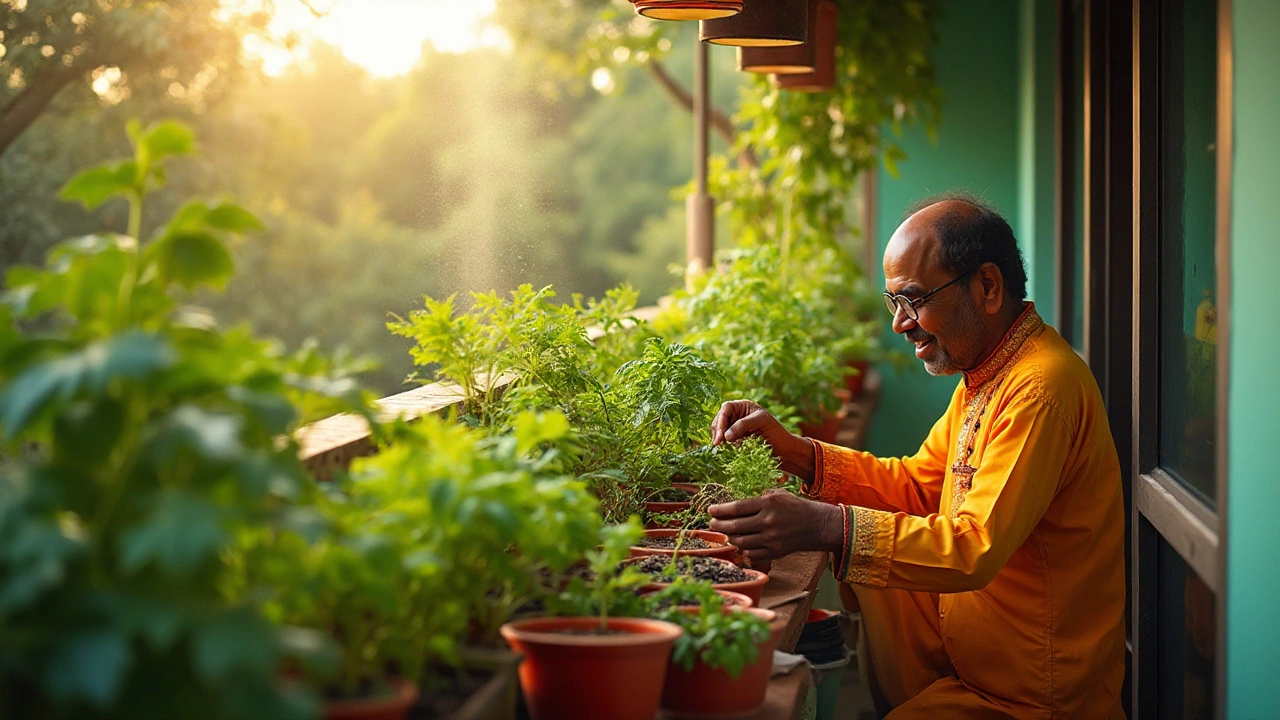Can I Mist Plants with Tap Water? What Every Indoor Gardener Needs to Know

Plenty of plant lovers have stood over their ferns, mister in hand, wondering if regular tap water could hurt more than help. Tap water has stuff in it—like chlorine, fluoride, and minerals—that your plants didn’t get back in the rainforest. Some folks say, "No big deal," but others swear their leaves got marked up or their calathea curled in protest.
If you're only thinking about raising humidity, misting is a quick fix. But the water you use can actually build up on leaves (ever seen those white spots or crispy edges?), especially if your water has lots of minerals. And let’s be honest, nobody wants their gorgeous monstera getting chalky streaks.
So, if you want to avoid drama in your plant collection, knowing what’s in your tap water—and how your favorite plants react—makes all the difference. It might seem harmless to mist with whatever comes out of the faucet, but some species are way more sensitive than others. Let’s break down what you really need to know before you spray, so you can keep your indoor jungle thriving instead of just surviving.
- What’s in Tap Water—and Does It Matter?
- How Misting with Tap Water Affects Your Plants
- Plants That Love or Hate Misting
- Tips for Healthier Misting
- Better Alternatives for Sensitive Plants
What’s in Tap Water—and Does It Matter?
It’s easy to grab a spray bottle, fill it with tap water, and start misting. But what’s actually in that water? Most tap water isn’t just straight H2O. There are all kinds of extras added, with good intentions for humans but not always for indoor plant care.
The biggest things you’ll usually find in tap water include:
- Chlorine: Added by city water suppliers to kill bacteria. Too much can stress out delicate foliage, especially in tropical plants.
- Fluoride: Sometimes added for dental health. But plants like spider plants and peace lilies can get brown tips from fluoride over time.
- Calcium and Magnesium: Called “hardness,” these minerals cause limescale deposits. They show up as white spots on leaves after frequent mist plants with hard water.
- Other Stuff: Depending where you live, your tap water could also contain trace metals or salts.
If you’re curious what’s in your actual tap water, check your city’s water report. Or just fill a glass and let it dry—white residue or spots mean you’ve got some hard water minerals going on.
In the big picture, not all indoor plants are bothered by tap water. But here’s the kicker: some plants are much more sensitive than others. If you keep misting with hard or treated tap water, the residue can build up on leaf surfaces, blocking sunlight and messing with how your plant "breathes." It can also leave your leaves looking beat up, with crispy edges or faded colors.
| Common Tap Water Additive | Plants Most Sensitive |
|---|---|
| Chlorine | Ferns, Calatheas, Orchids |
| Fluoride | Spider Plants, Dracaenas, Peace Lilies |
| Hardness (Calcium, Magnesium) | All plants can get leaf spots, but prayer plants show it fast |
So, before you reach for the spray bottle, it’s worth thinking about what your water’s bringing to the table. Misting can be great in the right conditions, but if your water’s loaded, your plants might not thank you for it.
How Misting with Tap Water Affects Your Plants
Misting your plants might seem harmless, but using tap water can actually mess with them in subtle ways. City tap water usually contains chlorine, some have added fluoride, and many places have "hard" water loaded with calcium and magnesium. Ever noticed those pesky white spots on your plant’s leaves after misting? That’s mineral buildup, and it can block sunlight or clog up your plant's pores, making it harder for them to breathe.
Certain plants, like those with fuzzy leaves (think African violets), are especially sensitive to tap water. Droplets can sit on leaves and invite fungal problems, and the minerals can leave marks that never come off. Some tropicals, including calatheas and prayer plants, have been known to sulk with brown edges or patchy discoloration when misted often with regular city water.
- Chlorine and chloramine can stress out sensitive plants, especially if it builds up over time.
- Fluoride might cause leaf tip burn in plants like dracaenas or spider plants, which show up as crunchy tips.
- High-mineral (hard) water leads to those dull, powdery spots, which don't wash off easily.
Curious if your water is causing trouble? A home water hardness test can tell you if you’re misting tough spots onto your beloved green friends. Water quality really makes all the difference with regular misting. In fact, check out this snapshot of how some common additives in tap water can show up on your leaves:
| Tap Water Additive | Effect on Plants |
|---|---|
| Chlorine | Stunted growth, leaf spots on sensitive types |
| Fluoride | Brown leaf tips (especially dracaena, spider plant) |
| Calcium & Magnesium | Fine white spots, streaks |
You probably won't kill a pothos with tap water mist, but picky houseplants will complain fast. If your plant family is mostly hardy, you might not notice much. But, if you’ve got a collection of fussy tropicals, you might want to rethink how you mist—or what water you use.

Plants That Love or Hate Misting
Misting isn’t a one-size-fits-all thing. Some houseplants practically cheer for a daily spritz, while others just get cranky or develop ugly spots if you so much as look at them with a spray bottle. So which plants actually like you to mist plants with tap water, and which ones wish you’d knock it off?
- Love the Mist:
- Ferns (Boston, Maidenhair, Staghorn): These guys thrive in shady, damp forests out in nature. They’ll happily take extra humidity, even if your tap water isn’t perfect—though distilled or filtered is still ideal for avoiding leaf spots with sensitive types like Maidenhair.
- Calatheas, Marantas (Prayer Plants), and Fittonia (Nerve Plant): All love humidity, but watch for mineral marks if your local water is hard. They’ll definitely let you know they’re unhappy by browning at the edges.
- Tropical Palms: Parlor palms and their cousins really perk up with a gentle mist. Don’t overdo it if you notice any powdery residues, though.
- Hate the Mist:
- Succulents and Cacti: These are desert dwellers. Misting can make them rot, especially if water sits in the leaf joints. Skip it—they like dry air.
- Pileas and Peperomias: These might not protest outright, but they don’t really need misting. Extra moisture can encourage fungal spots.
- Orchids: It feels like they’d love humidity, but misting the actual leaves and stems is risky. Water pools in their crevices can lead to rot and disease.
A quick way to check if your plant wants that humidity boost? Look at where it’s from. Rainforest or cloud forest backgrounds mean your plant’s probably yearning for a spray, while desert and arid regions mean misting is a bad idea.
Here’s a snapshot of how different indoor plants react to misting:
| Plant Type | Ideal Misting | Common Issues w/ Tap Water |
|---|---|---|
| Boston Fern | Yes | Leaf spots if water is hard |
| Maidenhair Fern | Yes | Brown edges, mineral dusting |
| Calathea | Yes | Browning if chlorine/high minerals |
| Succulent | No | Root and stem rot |
| Orchid | No (use humidity tray) | Rot, fungal spots |
Don’t forget: even with "misting-friendly" plants, using tap water that’s loaded with minerals or chlorine can eventually leave marks or stifle growth. Keep an eye on your leaves—they’re better at telling you what works than any rulebook.
Tips for Healthier Misting
If you’re set on mist plants with tap water, there are some basic things you can do to avoid stressing out your indoor green friends. First off, let tap water sit out overnight. This lets most of the chlorine evaporate, making it way gentler on delicate leaves. Not all minerals will leave, but it’s still better than using fresh-from-the-faucet.
Grab a mister with a fine spray. The finer the mist, the less likely you’ll see water spots or stuck-on mineral deposits. Those big, heavy droplets are basically water stains waiting to happen, especially if your tap water’s hard.
- Mist in the morning so leaves have time to dry before it gets dark. Damp leaves overnight can encourage mold or rot, and nobody wants that.
- Avoid spraying flowers or fuzzy-leafed plants (like African violets)—they’re magnets for spots and rot.
- Test a small area first. If your favorite fern suddenly looks patchy, try switching to filtered or distilled water.
- Keep your mister clean. Bacteria and fungus love a warm, damp nozzle.
Hard water leaves more marks. Curious if your tap’s got high minerals? You’ll know if you see crusty spots on leaves or even around your sink faucets.
| Water Type | Chlorine | Minerals | Best for Misting? |
|---|---|---|---|
| Fresh Tap | High | High (varies) | Not ideal |
| Tap (stood overnight) | Lower | High | Better |
| Bottled/Distilled | None | Low | Great |
If you want to get fancy, use rainwater—plants love the stuff, and there’s no risk of tap water damage. But you really don’t have to break the bank. A simple filter pitcher knocks out a lot of the harsh stuff and works for most indoor plant needs.
Bottom line? The way you mist plants matters almost as much as what you mist with. Get these basics down and you’ll cut down the leaf drama big time.

Better Alternatives for Sensitive Plants
If your leafy friends tend to throw a fit after a mist plants session with tap water, you’ve got options. Some indoor plants, like calathea, prayer plant, or some orchids, really don’t appreciate all the extras that come with standard city water.
The gold standard for these picky types? Distilled water. Distilled water has none of the minerals or chemicals that leave spots, so your fussy plant won’t develop crispy leaves or dull patches. Another solid choice is rainwater—just collect it in a clean container and use it up within a week or two. Both options are actually closer to what these plants get in the wild, which explains why they love it so much.
If you’re looking for something even easier, investing in a simple water filter (like a Brita pitcher) helps a lot. These filters take out chlorine and some minerals, making your misting routine safer for your sensitive indoor plants. You don’t need a fancy setup; even affordable pitchers will make a big difference.
Here’s a quick comparison of water types and what they offer:
| Water Type | Removes Chlorine? | Removes Minerals? | Plant Safe? |
|---|---|---|---|
| Tap | ✗ | ✗ | Sometimes |
| Filtered (Brita) | ✓ | Some | Usually |
| Distilled | ✓ | ✓ | Always |
| Rainwater | ✓ | ✓ | Always |
One thing to keep in mind: never use softened water from home water softeners. The sodium in it can build up and straight-up ruin roots and leaves.
If you can’t get fancy water, try letting tap water sit overnight before misting. That lets chlorine gas off, which is helpful, but it won’t do much about the minerals. Just remember, for your high-maintenance plants, the extra step of using distilled or rainwater really pays off. Plus, you’ll save yourself the heartbreak (and cleaning chores) of ugly leaf spots and unhappy plants.




